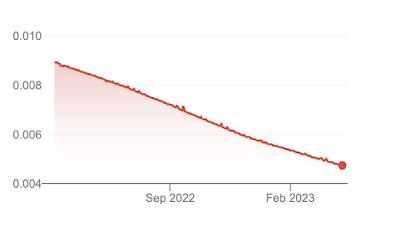Friday, April 07, 2023
Argentine pesos
We are in Buenos Aires now, enjoying great food, interesting museums, and big city life. At the moment, Argentina is much cheaper than Uruguay-- something almost every Uruguayan told us. A small bag of potato chips cost over $5 US in Montevideo is about $1 here. Our Uruguayan friends talked about shoes costing 1/5 the price on this side of the Río de la Plata, so loved coming her to shop. Restaurants, groceries, taxicabs are all much, much cheaper.
It's not always this way, but the value of the Argentine peso is falling faster than prices inflate so nearly everything here is a bargain for anyone with foreign currency.
Graphs like this are unusual in financial markets, since the future is too easy to predict... everyone expects the peso to continue falling in value, so no one wants to hold pesos. The actual market value of the peso is much lower than this picture shows. This is the official rate, currently $1 = 210 pesos, controlled by the Argentine government. The black market rate (called the Blue market here) is nearly 400 pesos to the dollar. Exchanging at the black market rate cuts the price of everything in half.In Uruguay, everyone had their trusted exchange guy in Buenos Aires-- a taxi driver, a white-haired man operating next to a florist, a guy who would deliver pesos to your door-- and they were happy to share their contacts. We have been changing money at the black market rate in an office on a big commercial street-- complete with two teller windows, marble floors, frosted glass dividers, velvet ropes between chromed stanchions, and bill-counting machines. It's not secret-- there is a big lighted sign above the entrance and the name is etched on the glass double doors. Apparently the black market is fairly grey.
The biggest bill in circulation is 1000 pesos-- only worth $2.50 US-- so paying for a hotel requires bundles of bills. Even buying dinner means counting stacks of dozens of notes. The smaller bills (10, 20 pesos) have so little value that they are often ignored at cash registers. Western Union was running short of 1000 peso bills, so customers were stuffing thick wads of 100 peso and 500 peso notes into pockets, purses, and paper bags that held the croissants they ate while waiting in line. An inch thick stack of 100 peso bills makes you feel rich, but its only worth about $25.
While Argentine products are super-cheap now, imports are really expensive here. A bottle of maple syrup cost over $70 at the official exchange rate. Ordinary salmon from Chile costs 4 times as much as prime Argentine streak. My wife is particular about coffee and much of the South American coffee doesn't meet her standards (wrong beans, processed with sugar) so she looked for imported coffee in the supermarket but it was simply unavailable. The same exchange rate that makes Argentina a bargain for us, makes imported good prohibitively costly.
Inflation is currently running over 100% annually. Many restaurants cover the old prices with stickers rather than re-print the entire menu. We ate a Don Julio, a famous steakhouse, and received menus with two different prices-- one was from last week and prices had already changed. We took the Mitre train to Tigre (about an hour's ride)-- a comfortable modern train-- and it cost 25 pesos, about 6 cents. Apparently government-set prices don't adjust as quickly as restaurants.
As a traveler, the huge difference between the black market and official exchange rates means you need to manage your cash carefully. Withdrawing from an ATM is at the official rate-- doubling your costs. Credit cards may exchange at the official rate or at a special tourist rate (close to the black market rate) but it's impossible to know at the time of a purchase. There isn't much dollarization (it may be illegal) so cash transactions in pesos are the norm. This means regular trips to a change dollars. There is a strong preference for crisp, clean US $100 bills. Worn currency or smaller bills may trade at a discount or be rejected entirely.
But, it's important not to exchange more than you will spend, since you can't change the pesos back into dollars. (Everyone wants dollars and no one wants to hold pesos.) The value of the peso is dropping quickly so they are likely to be worthless for travel in future years. Pretty much use it or lose it.
archives
- June 2006
- July 2006
- August 2006
- September 2006
- October 2006
- November 2006
- December 2006
- January 2007
- February 2007
- March 2007
- April 2007
- May 2007
- June 2007
- July 2007
- August 2007
- September 2007
- October 2007
- February 2008
- March 2008
- April 2008
- May 2008
- July 2008
- August 2008
- September 2008
- October 2008
- February 2009
- April 2009
- July 2009
- December 2009
- April 2010
- February 2012
- March 2023
- April 2023






